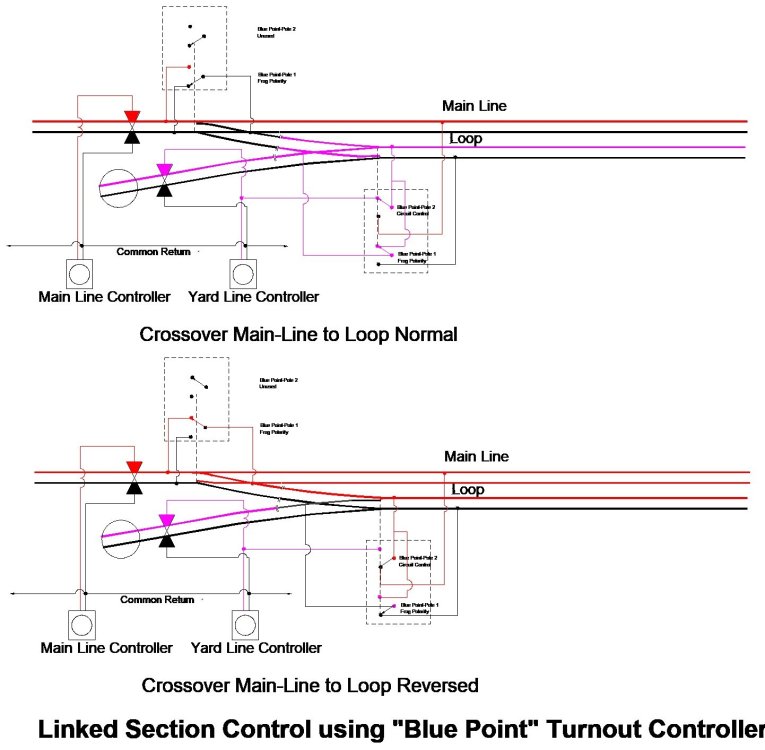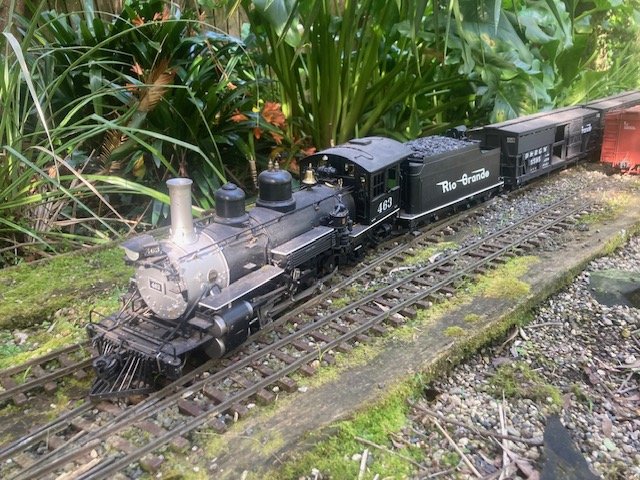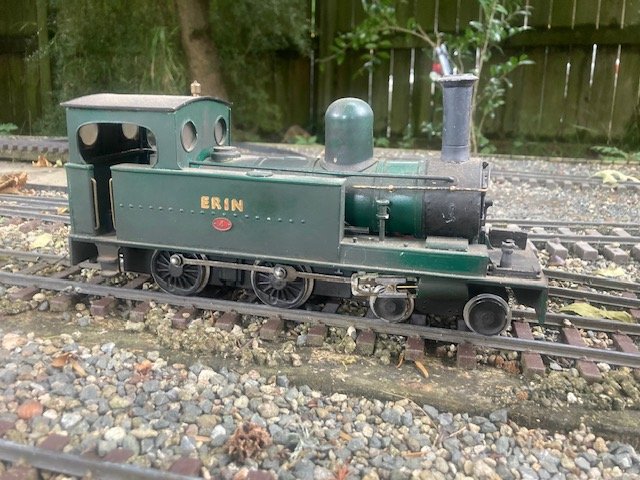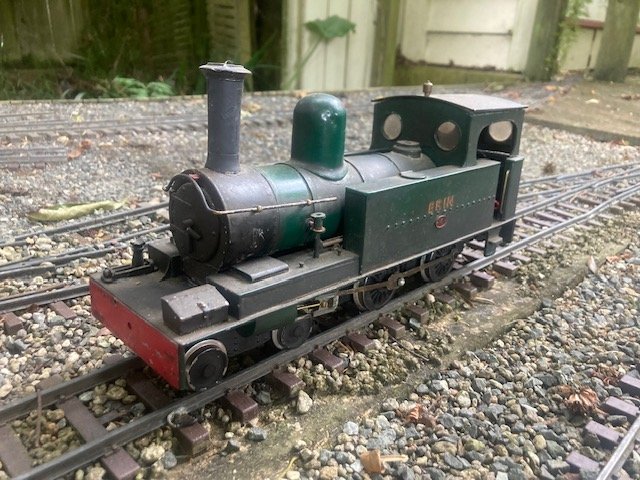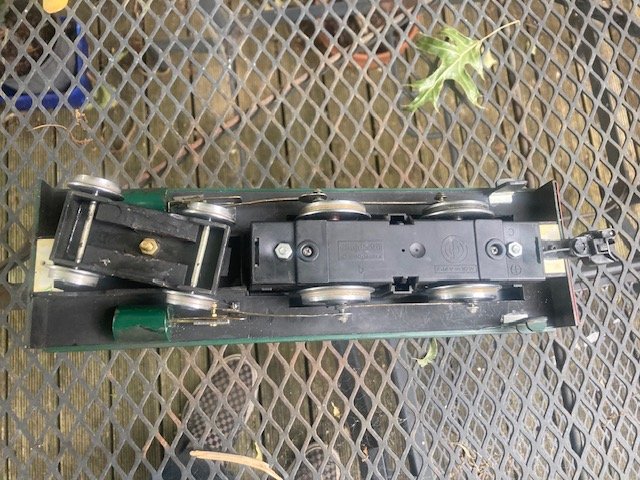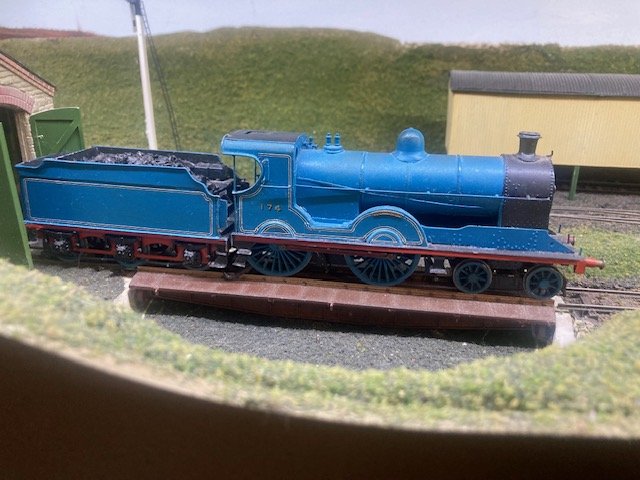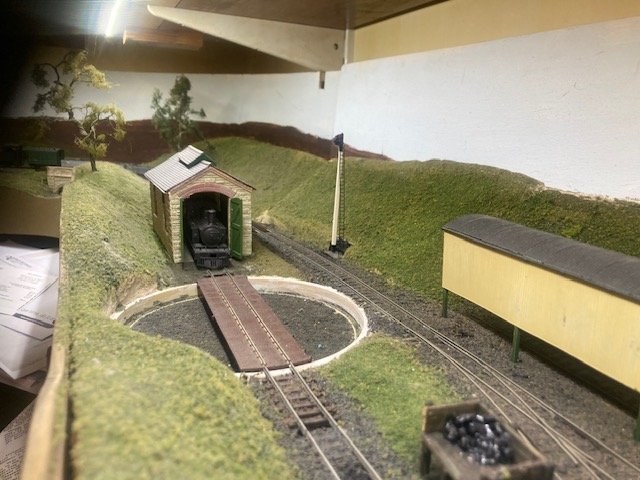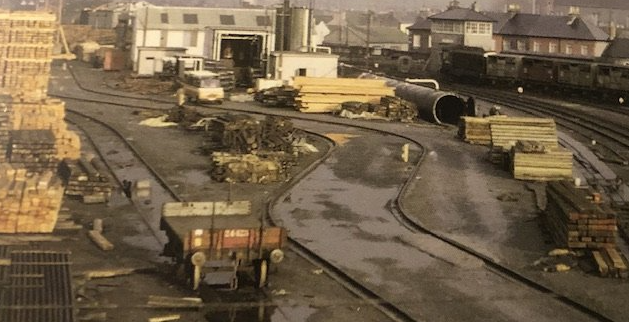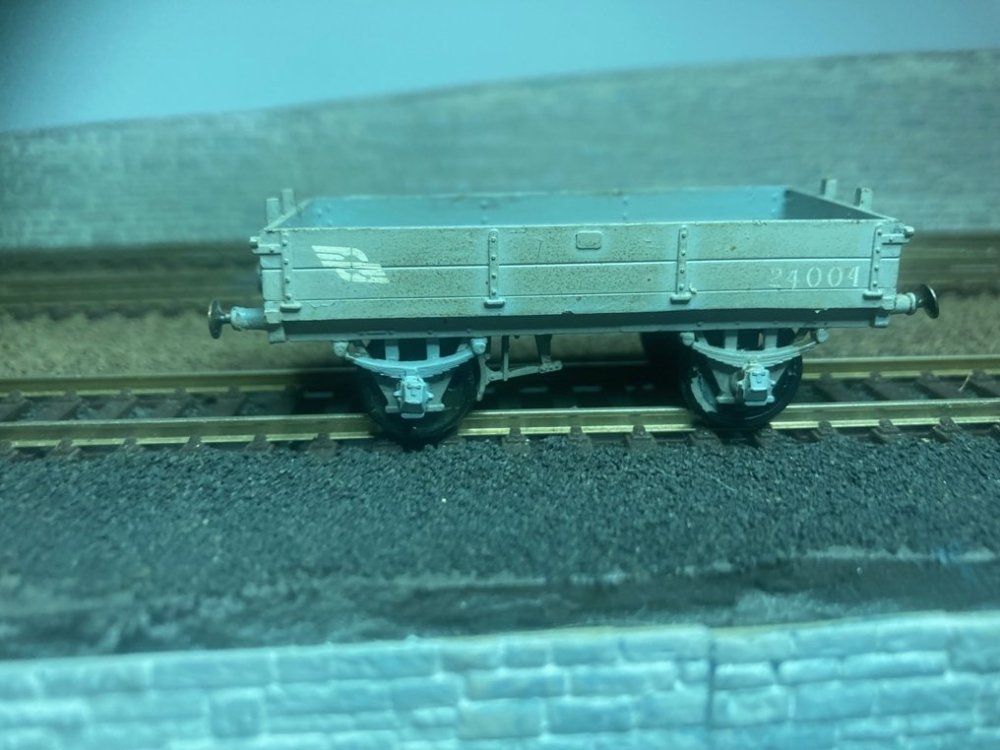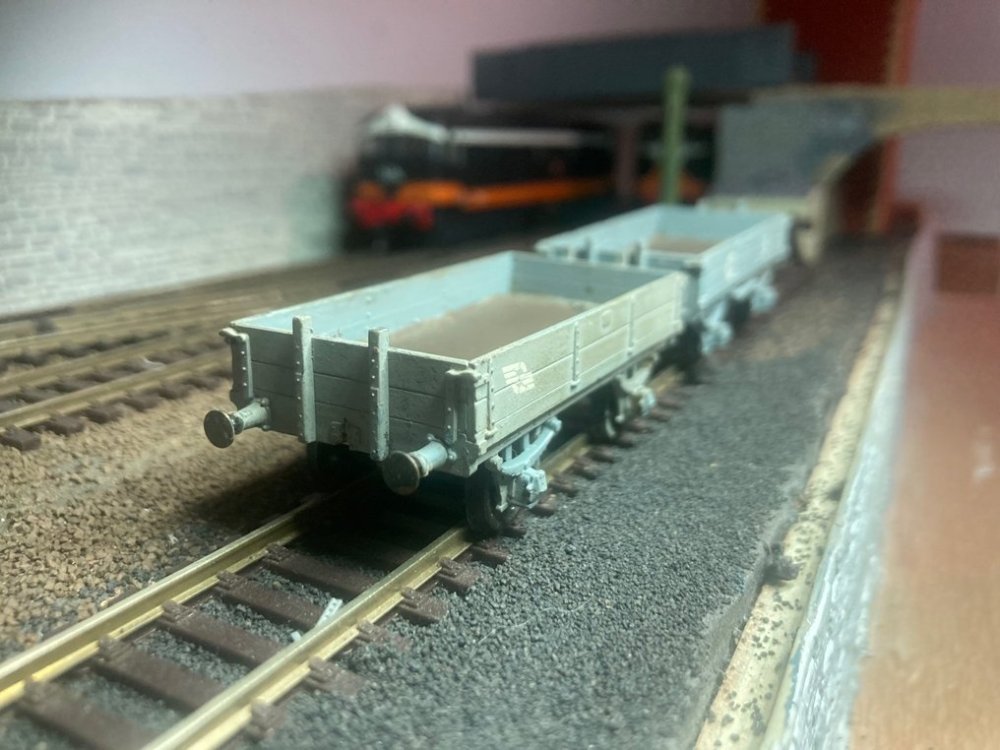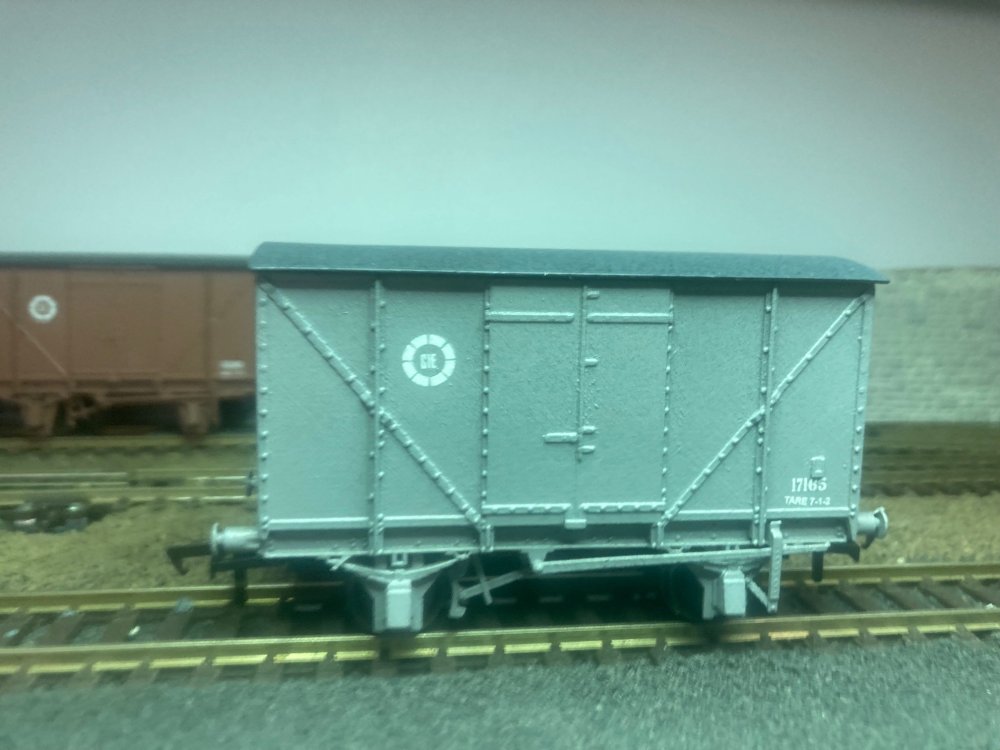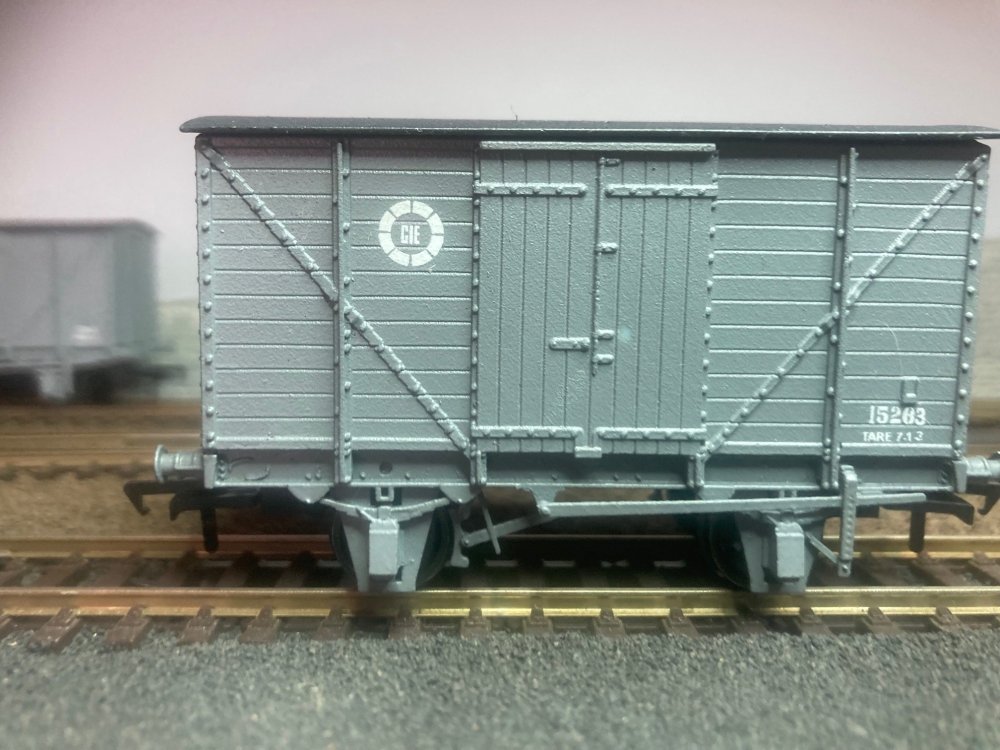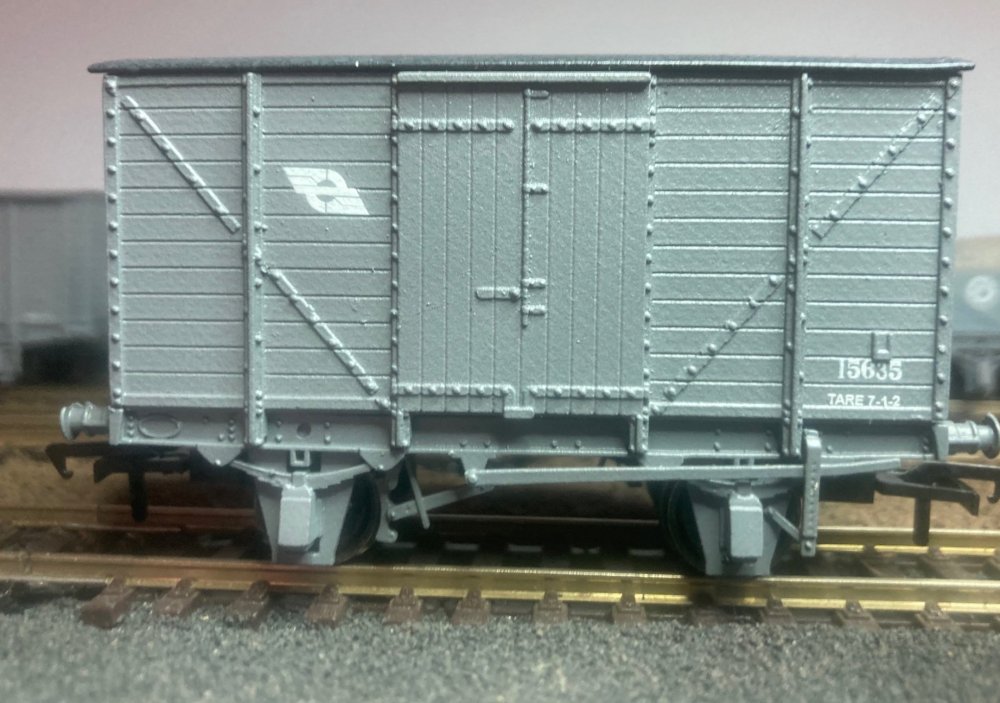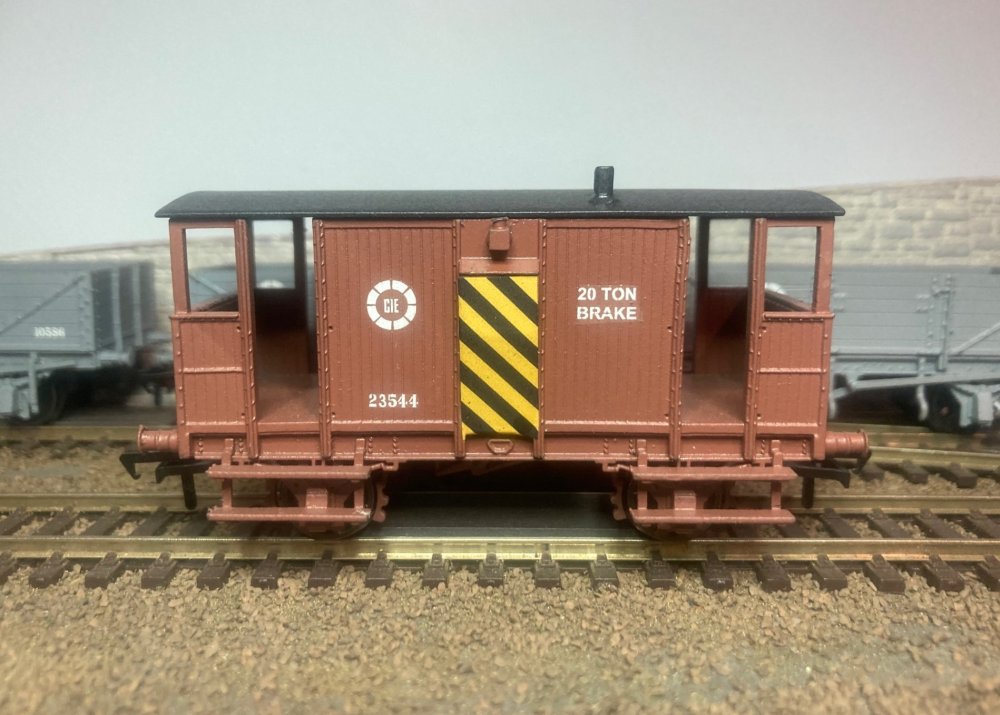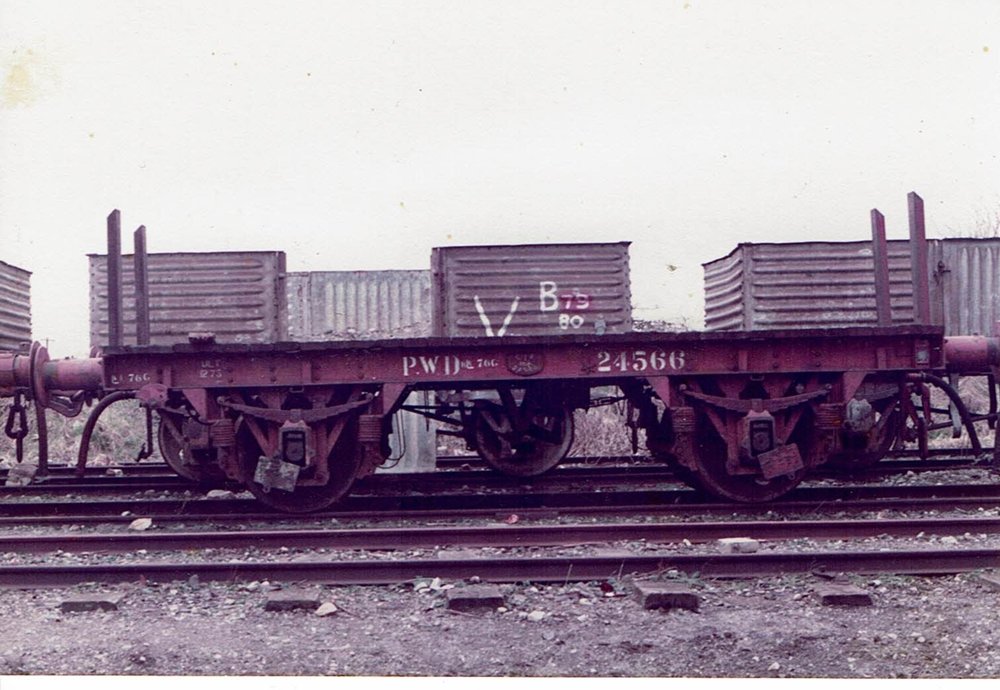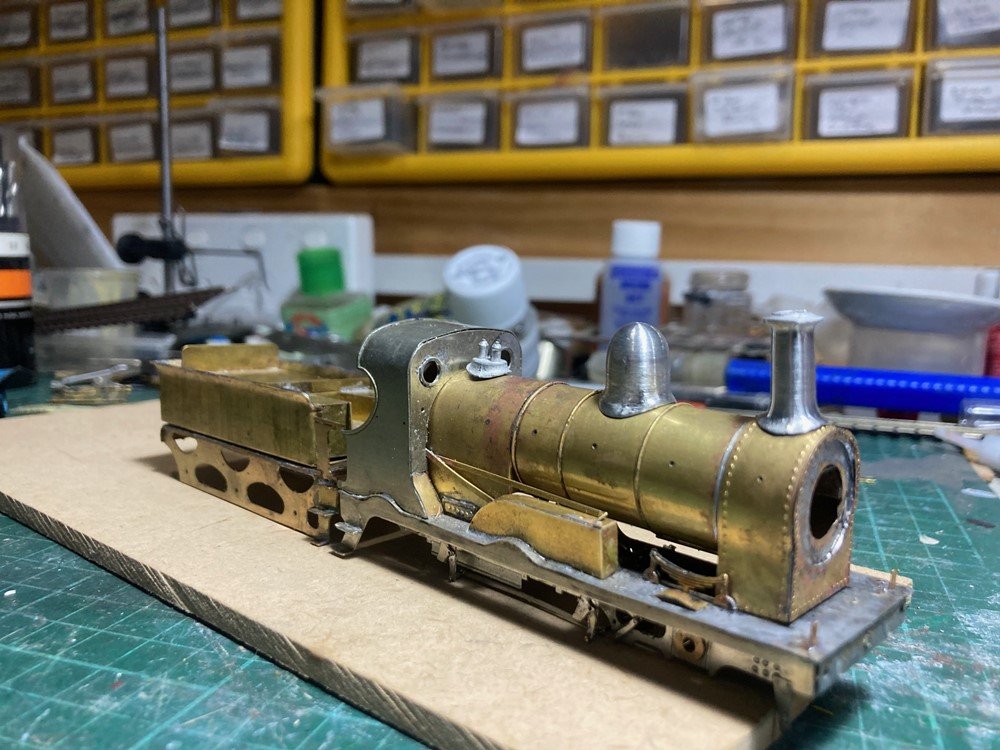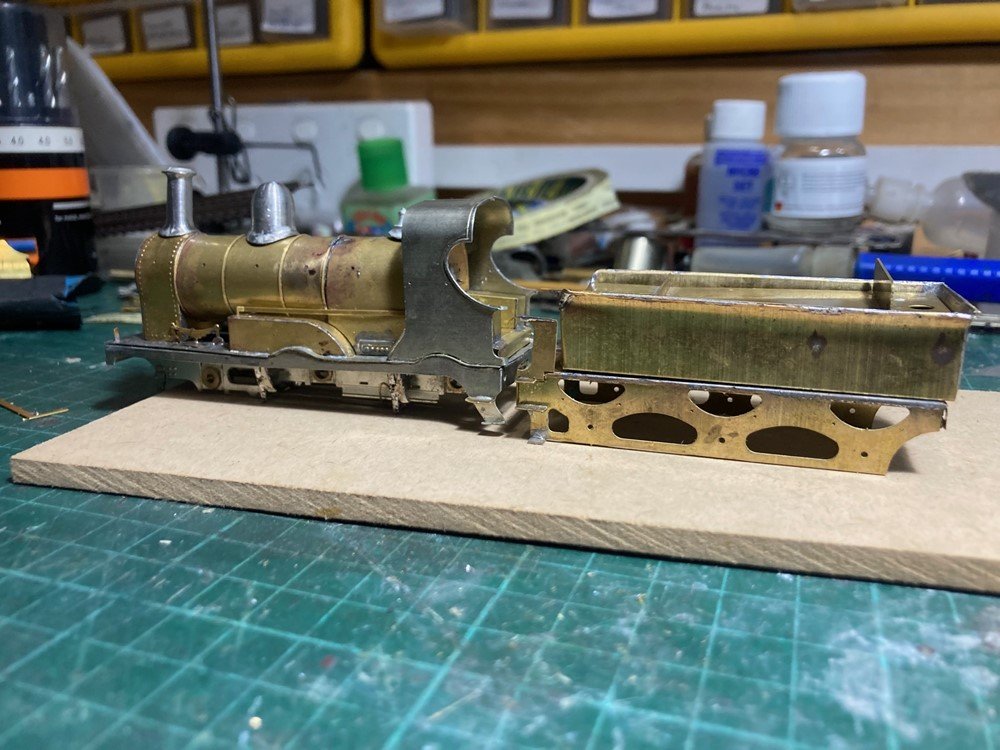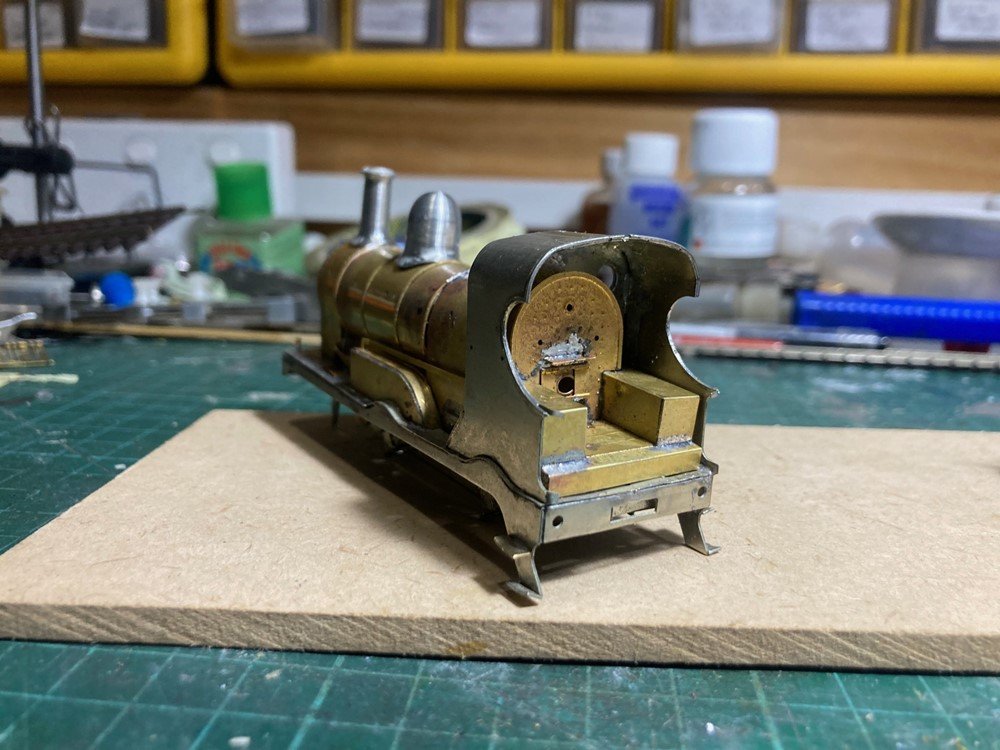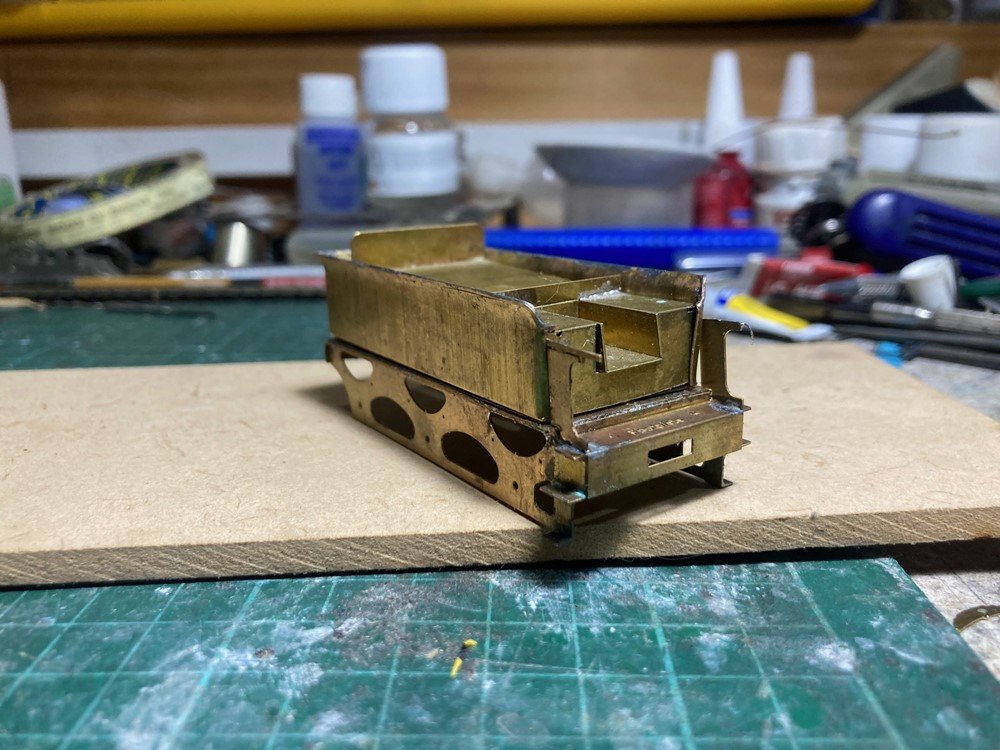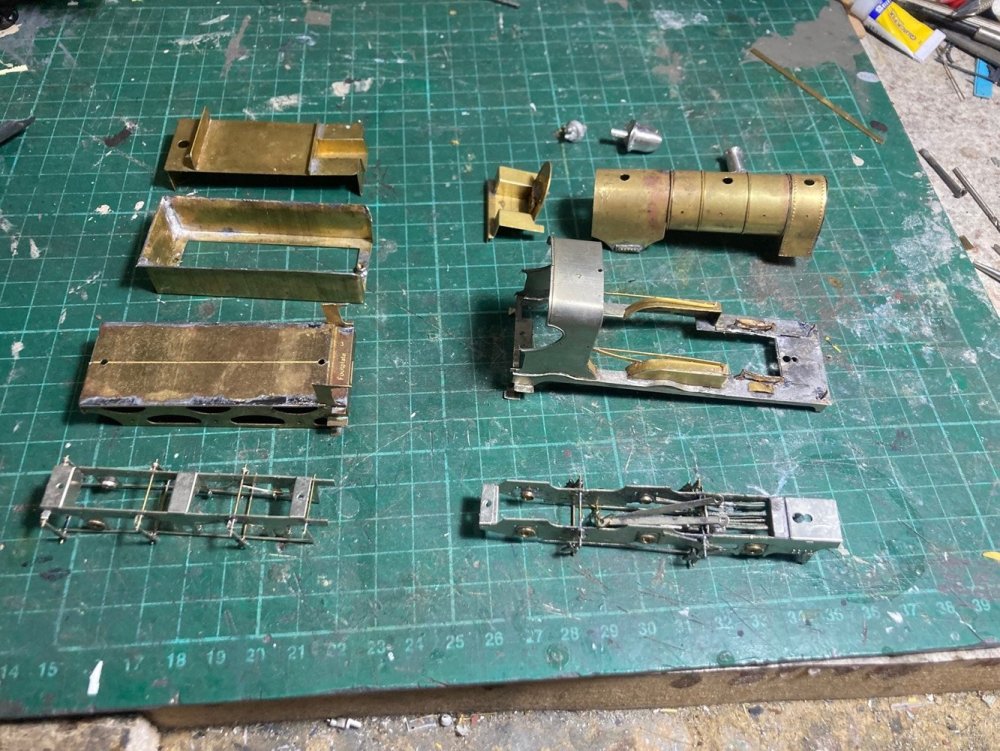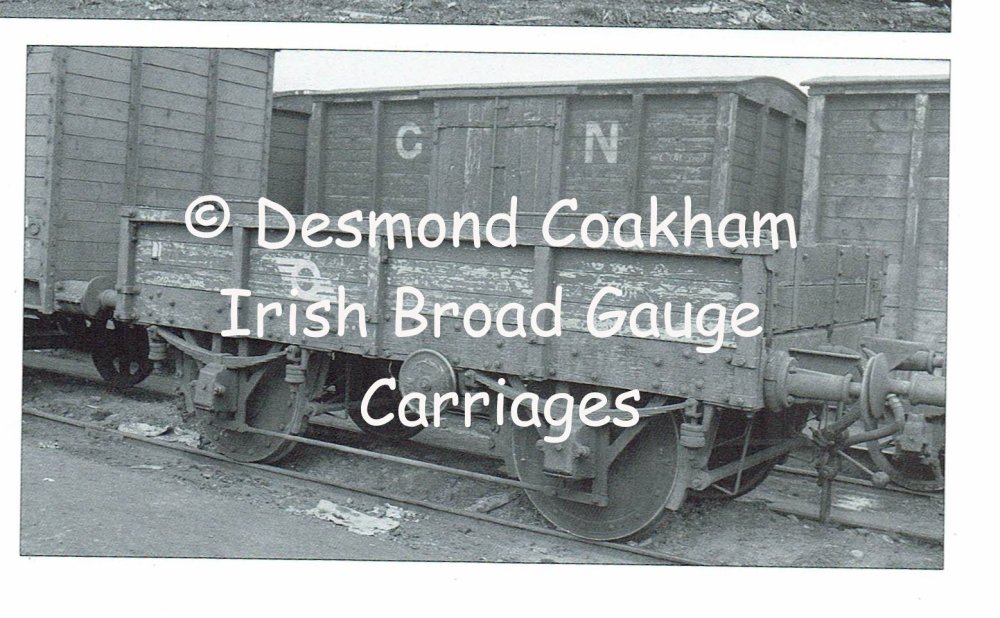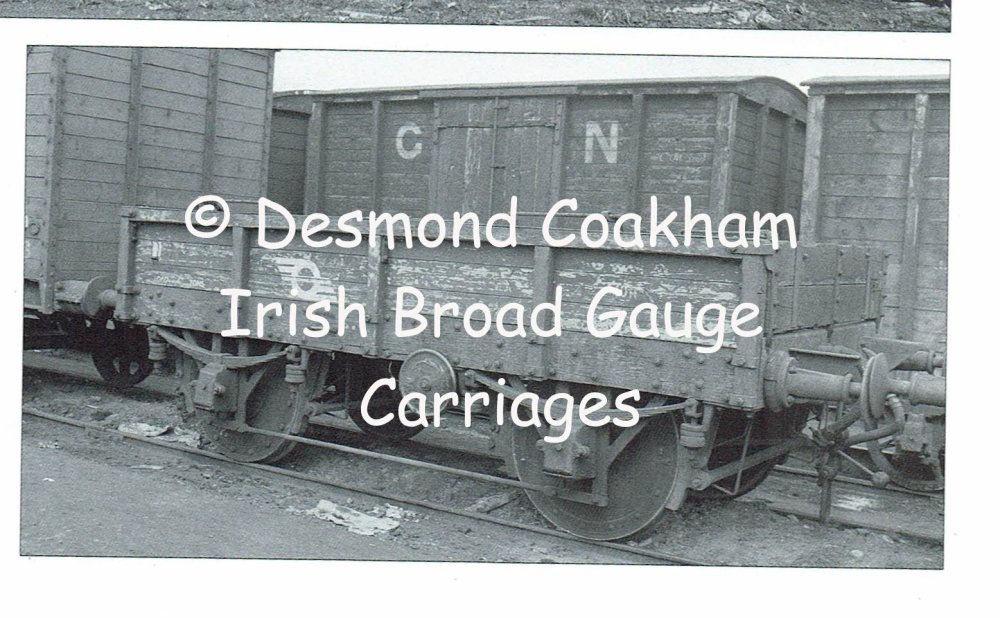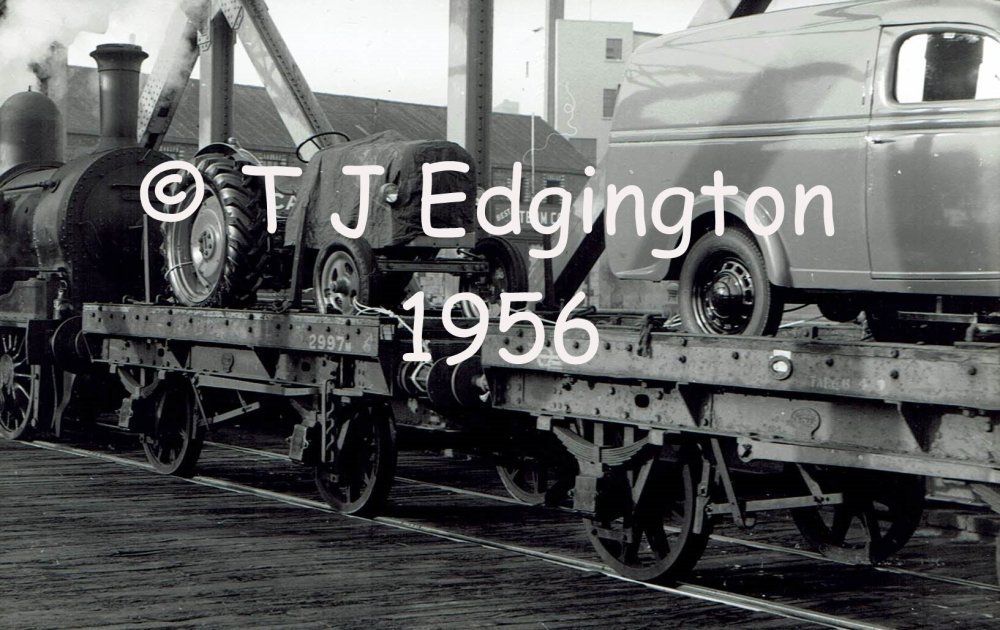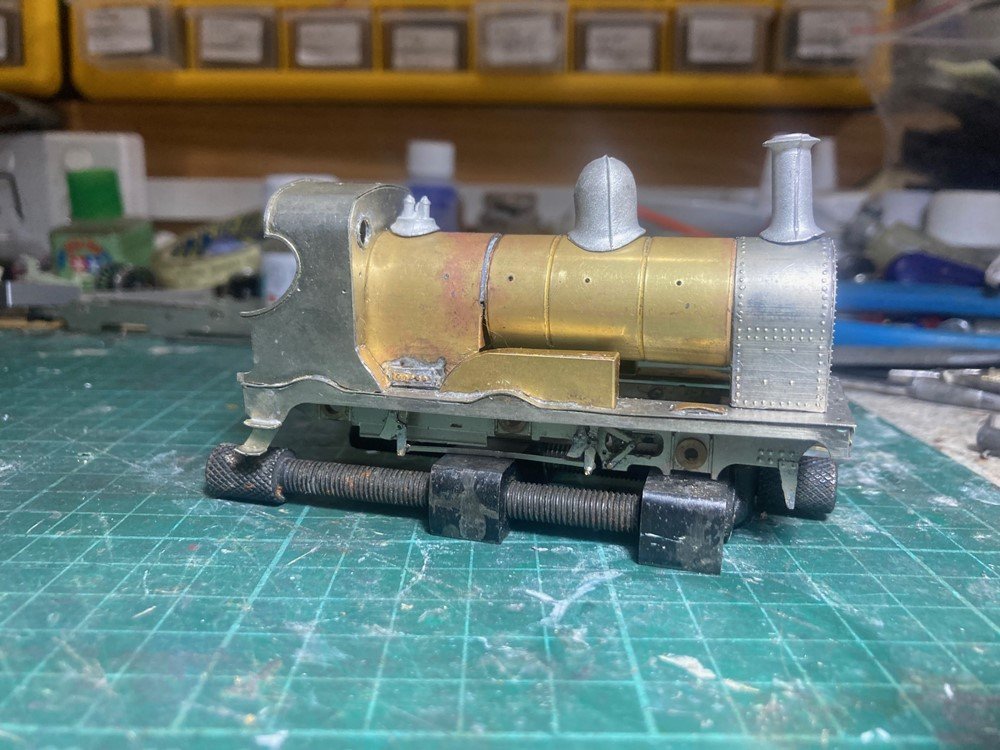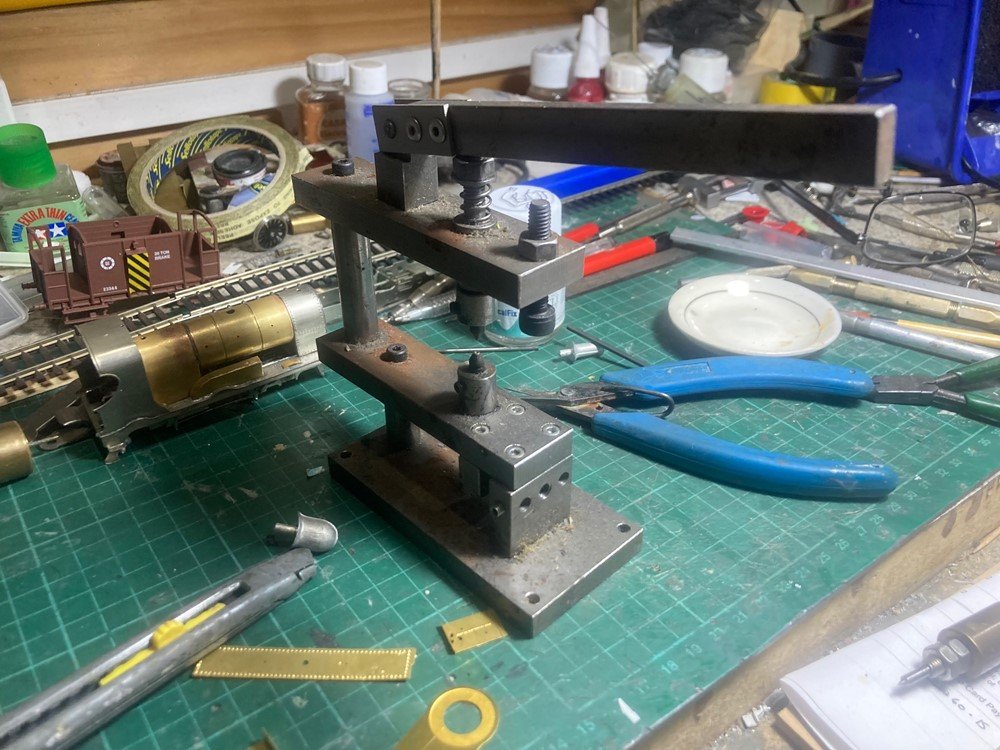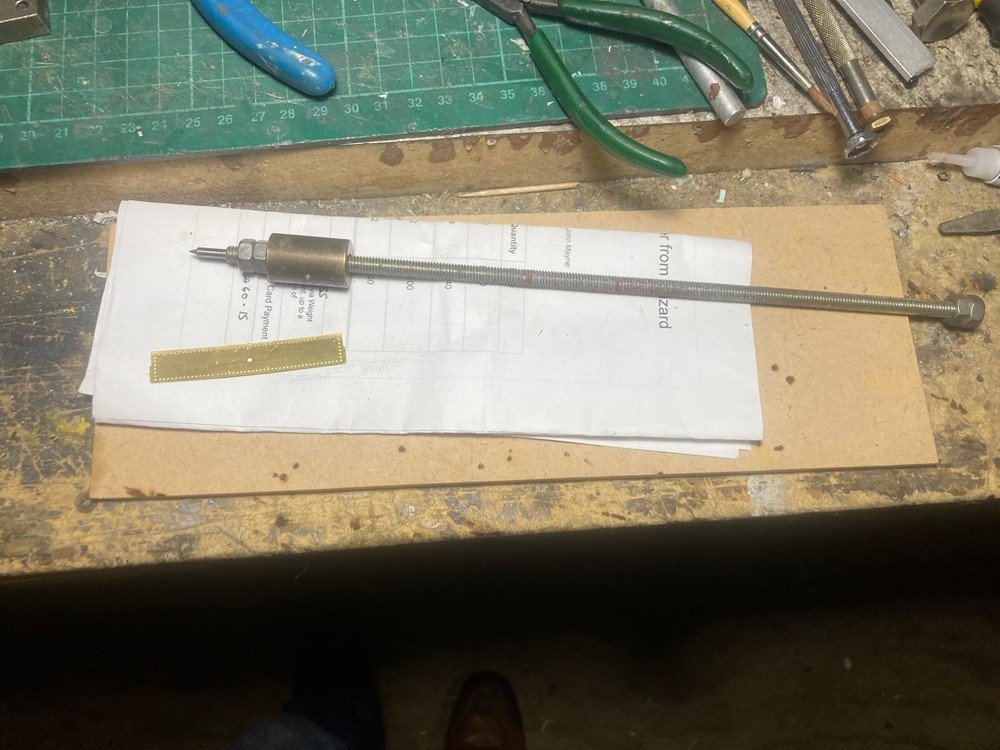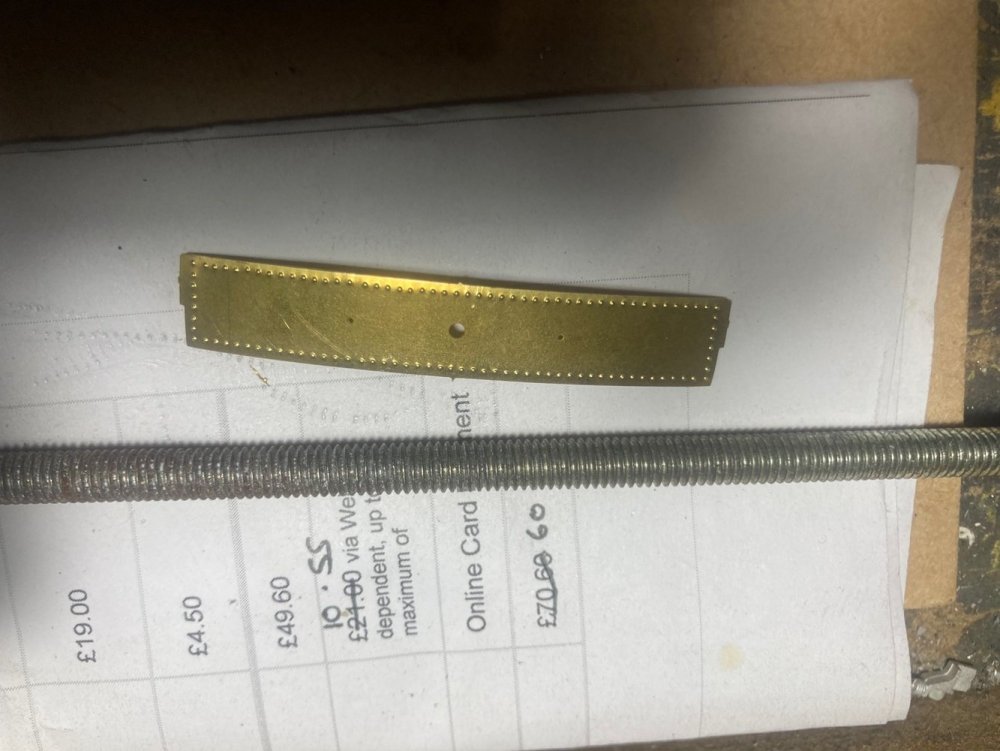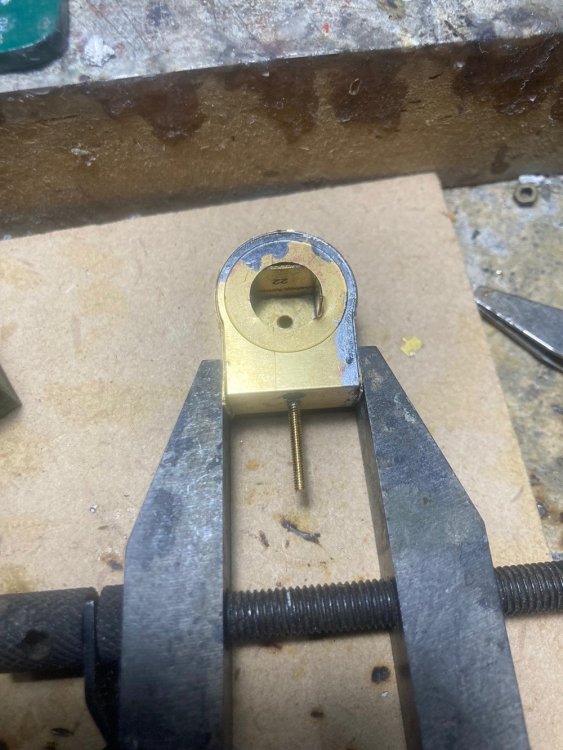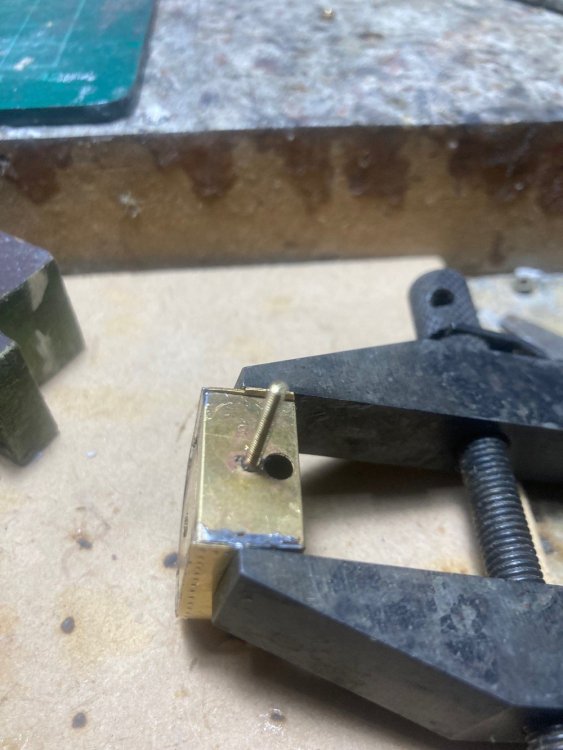-
Posts
4,879 -
Joined
-
Last visited
-
Days Won
119
Content Type
Profiles
Forums
Events
Gallery
Everything posted by Mayner
-
NorthWallDocker quite flattered that my writing about Keadue inspired you to build a C&L/MGWR layout. 1. I don't have anything more specific on Stewart Hines Model Railway Magazine wiring article, but may be covered in his "Model Railways' Haynes explains series 1977. https://www.amazon.com/Model-Railways-Haynes-explains-Stewart/dp/0854295461/ref=cm_cr_arp_d_product_top?ie=UTF8 I decided to try similar principals on Keadue using Blue Point machines with locally operated points and walk around control, eliminating the need for a control panel and section switches. The only section switches on Keadue are a number of switches that allow locos to be isolated on the turntable loco shed road. 1. Wiring Probably simplest to explain through wiring diagram of the crossover between the Main-Line and the yard at the Boyle/Sligo end of the yard, the arrangement at the Arigna/Ballinamore end of the yard is similar. The layout is currently controlled by two hand held controllers (1 Gaugemaster, 1 club project) that plug into DIN sockets in the baseboard fascia. Two sockets feed the main line at either end of the station, the main line feeds are conventionally wired at the toe end of the crossovers from the Main Line to the Yard. A third socket feeds the yard through a "heel feed" to the loco-shed road, locos on the yard are controlled by the "Yard Controller" when the crossover between the main and yard is normal allowing a train to run on the main line under control of the main line controller while another loco is shunting the yard. Reversing the crossover points allows trains to arrive and depart from the loop using a main line controller while simultaneously allowing locos to move/turn in the loco yard. I used the Blue Points on Keadue to test the concept for more complex application, using for routing power using the auxillary switches on Tortoise Switch machines on a future layout potentially using signals to control track power, but that's another days work! 2. Shelf baseboard width. I tend to use 12" as a maximum baseboard width on shelf or book case layouts in both N and 4mm, the relatively narrow baseboard with also helps make scenic sections look longer. I have set up 18" wide shelf baseboards for a future layout, (on extended proprietary brackets), currently used for storage has shown no signs of movement in over 10 years! 3. Minimum radius. The 90º curve on the Tramway Section is approx. 2' radius, though may be tighter in places. The Branchlines C&L 4-4-0T was designed with the bogie which slid on a central pivot complete with side control springs, which could be challenging to set up and reduced side to side movement. I converted both my C&L 4-4-0s to a more conventional bogie pivot arrangement, though the bogie wheels sometimes short on the inner edges of the whitemetal outside cyliners. Its likely to be more challenging to identify a workable minimum radius for the ex-CBPR 2-4-2T with their long wheel base and radial trucks fore and aft. I usually drawn or prepare a mock up of the chassis and wheels to check clearances on curves before assembling a loco. It may be worth contacting Phil 3150 who built a model of 10L from a Worsley Works set of parts. 4. Learnings: Keadue has evolved considerably during the 20 years since we moved to New Zealand. Originally intended as a self-contained shelf layout designed to fit an 8'X1' space in the home office and a test bed for readily available baseboard material and foam track underlay. The layout was extended to an L shaped terminius to fiddle yard (11'X6') shelf layout with scenic works substantially complete just in time for a Model Convention in which delegates visited the layout 8 years later! Apart from maintenance and some additional stock I have done very little work on Keadue since the convention. The main lesson has been not to use MDF as a trackbase material if planning to use water as a wetting agent when gluing down ballast, at the time I used MDF as it was difficult to source good quality stable plywood from builders merchants or DIY superstores. I now buy ply from a specialist ply and veneer stockist. Although I have an almost life long interest in the C&L, I tend to switch between projects, scales and prototypes which had a knock on effect on Keadue.
-
Another factor is the absence of wealthy sponsors/owner operators like Alan Peglar, Robert McAlpine, and Ian Welsh (New Zealand) from the Irish preservation/excursion train market. Peglar and McAlpine were responsible for the preservation and restoration of the "Flying Scotsman". Peglar was one of the pivotal figures in preservation, buying the locomotive outright, paying for its professional restoration and persuading BR to allow the loco to run on its metals. Peglar ran out of money and went broke when the Scotsman was touring the United States during the early 70s, McAlpine bought the loco and returned it to the UK. Ian Welsh the founder of New Zealands "Main Line Steam Trust" is claimed to have the largest private collection of main line steam locos in the World, with collections in New Zealand and South Africa. https://www.mainlinesteam.co.nz/history
-
The red scheme for PW wagons appears to have been rare possibly at the time few people were taking colour photos of wagons. There are a number of colour photos of 'red' PW wagons in the Wagon collection on the IRRS Flickr site, including a freshly repainted ex-GN 6w Ballast Wagon complete with wheel logo and a couple of more workday photos including GSWR/GSR/CIE Dropside Ballast with wheel logo and older style of Ballast Hoppers. The different colour scheme may have been intended to distinguish PW from revenue stock, the GSR apparently painted narrow gauge C&L Ballast Ballast wagons yellow/brown during the 1930s. The IRRS Flickr site is a real eye opener with colour photos of pre-Amalgamation wagons in service into the late 60s including ex-Midland and West Cork Open Wagons (Irish Standard Open) and a MGWR Covered Wagon (similar to GNR) in brown with wheel logo). I guess I will have to add some of these wagons to my collection.
-
He (the bull)is supposed to have escaped from a slaughter house, done well if he has been adopted by an animal sanctuary.
-
A mystery solved, there is a 1969 Tom Wall photo of 24401-24515 series Ballast Wagon 24514 in the IRRS Flickr album https://www.flickr.com/photos/irishrailwayarchive/51907052281/in/album-72157661623942928/ The photo is copyright and the download option is disabled. The wagon is a 2 plank dropside with tapered steel end stanchions, the traditional Irish wooden underframe betrays its origin as a cattle wagon. Interestingly the body (sides and ends) are painted red on a grey underframe, the wheel logo is positioned near the centre of the body. There is also a photo of an older version of the 'Ballast Wagon" loaded with sleepers, sides removed and offcuts of rail used as stanchions, Possibly a new wagon for Leslie, all my wagons run on the steel versions of the "Standard' underframe.
-
Its worth while looking at the option of battery rather than track power for a garden railway. Some very good/reliable cheap Chinese "Wild West" battery sets with radio control https://www.ebay.com/itm/374239915861?hash=item57226fef55:g:yzQAAOSwg01jE9Qr&amdata=enc%3AAQAIAAAA8Dih0xr0hI9tHsF2r2f7LKUVYw7RliQXv8sNykgCHW826cv6zOt1YzufhQvwXk8aAcvmypFKHNzzCn7hYzdaB4fXSsiOjiiXgUU%2FStASKPWPdZgm%2B9ceE%2Bkq5dwXgUnO9J9nlsdxzia2lXzu5dVWJaZ1roJfqo9DoYZg67wa0k%2BhBDcyIJbTMXOYxUJwcOLfKdy5OnR%2Fz5BDpC%2FxVcp9zwQEtSqH3w0wDeewOI0jwdBtH6pvXUBpFQLCiEmyXCyvRQ4cmwYmaz4KoDj%2FH9OUnKmxqxA1YiFnISup5TvuUkeORGg7A4qhfT%2BL5PrPNmurDQ%3D%3D|tkp%3ABk9SR5z2otGQYw The Wild West Set once available through the NZ equivalent of Walmart or Tesco Superstore was popular with garden railway modellers, who sometimes kitbashed the locos and stock into models of British outline narrow gauge. I bough a set for my daughter when she was 2 and the engine was still going strong when we donated it to a charity shop when she was 13. I use battery remote control on my garden railway using a system similar to RC Trains https://www.rctrains.co.uk/Receivers.htm , Crest Revolution is a more widely available battery RC system https://www.revoelectronics.com/. Most of my locos are American 3' narrow gauge proprietary models mainly of brass construction with a couple of kitbashed Bachmann locos. The Accuracraft DRGWR K27 2-8-2 463 is basically the pride of the line and very heavy with batteries and electronics in the tender I have one Irish 3' gauge loco a model of Schull and Skibbereen 'Erin' with a scratchbuilt plasticard body on an early Playcraft (LGB) 0-4-0 chassis. The model is likely to be 20+ years old bought second hand from its builder in the UK, with no sign or warping or deterioration to the plasticard body. I started to convert the loco to battery RC with a LiPol battery in the boiler, but had second thoughts with the fire risk early liPols Chassis block is Playmobile (made by LGB) bogie fabricated from plasticard. I need to fabricate a replacement cow catcher after the original was damaged.
-
Printed Branchlines catalogues/leaflets were supplied 'free' when I ordered some motors and gearboxes about 12 months ago.
-
The Peco or Dapol OO Gauge turntable kits are probably the cheapest and most straightforward options for installing a turntable, a number of specialist manufacturers including London Road Models produce 45-50' tables but they are expensive and not really suitable for an in-experienced modeller https://www.rmweb.co.uk/blogs/entry/17974-building-a-london-road-models-50-turntable/ Although a CIE 121 Class Diesel Loco will just about fit on the Peco HOn3 turntable, I would recommend 50' as a minimum if you are planning to run tender locomotives! Not sure if the Peco N or HOn3 turntables would be up to it for regularly turning heavier OO gauge locos (both N & HOn3 tables shareb a common well and pivot arrangement. Probably the most important point to consider is that a turntable takes up a lot of space on a baseboard, the Peco and Dapol turntables are over 300mm in diameter. The Peco HOm turntable on my narrow gauge layout takes up most of the space between the running line and the baseboard edge. If you are building a table from a kit or scratch considerable care is required in the set up of the turntable pivot point and rails on the deck, pivot point has to be positioned in the centre of the pit and deck and the rails/track set up so that everything is symetrical if the turntable is to operate correctly. My turntable is operated mechanically using Mecano parts based on a diagram in a very old (1960) C J Freezer book on model railways, table is aligned by eye. Some modellers use electric motor drive with quite sophisticated solenoid operated indexing arrangements, others use stepper motors. I also have a pair of turntables on a G Gauge garden railway, purely functional turntable decks/trackbases are simply strips of wood pivoted on galvanised coach bolts, track is aligned by eye with a locating pin arrangement soldered to the rail web 100% reliable in over 10 years use.
-
Interesting one Mogul possibly another example of CIEs practice of rebuilding redundant wagons for PW use The Flat in the photo appears to be another example of CIEs practice of converting redundant traffic wagons for PW purposes. The number on the end appears to be numbered in the 244xx series. Locomotives and Rolling Stock of CIE and NIR (1979) indicates that Ballast Wagons 24401-2415 were converted for 1953 built cattle wagons in 1964. I haven't seen a photo of these particular wagons, traditionally GSWR/GSR/CIE Ballast Wagons were two plank dropside wagons with fixed ends, sometimes with end stanchions. Its possible the sides were removed from wagons used to carry sleepers. Sides and ends "Ballast Wagon" conversions carried out in the 70s The ballast wagons in the Ratio LNWR PW Wagon Pack were a reasonably close approximation of the GSWR/GSR/CIE two plank Ballast Wagon complete with Irish style brake gear, though shorter and on a wooden underframe. The Bolster Wagons in the set looked reasonably close to the "Irish Standard" version of the Flat Wagon. Assembled many years ago this wagon has lost its brake lever, CIE Snail and stencil lettering was by Blackham Transfers. Transfers were rub-on with little scope for adjustment once in place. Fixed ends with extended posts, Irish wagons tended to use a T angle
-
A (very) small number of RTR wagons are available from stock for delivery mid-February 2024 (NZ basically shuts down from Christmas to mid-January) Basically we assembled our stock of CKD kits because we have not received orders or enquiries in recent months. We are planning to carry a small number of CKD Brakes, Van and Opens in stock from February 2024 onwards allowing orders to be fulfilled within a 3-4 week timeframe. The 20T Brake Van to be available with both planked and sheeted duckets. A John Edgington proto indicates that vans with sheeted duckets were in use since the mid-1950s allowing a greater variations in livery. 20T Brake sheeted duckets 23544 $85.00 nz ----------€49.95 at current Shopify rate. GSWR/GSR/CIE Covered Wagon with aluminium sheeted body and planked doors Flying Snail. Inspired by a photo in Loco Motives and Rolling Stock of CIE and NIR (79) $85.00 nz ----------€49.95 at current Shopify rate. I came across a grounded example in a field near Kinegad about 20 years ago. There was horizontal planking behind the aluminium sheeting, the sheeting presumably used to protect the planking from the weather allowing softwood rather than hardwood planking to be used. CIE 1946 version of the Covered Wagon. Similar construction to the sheeted GSWR van but on a 10' wb chassis. Some of the '1946 Vans" are available at a discount the angle strapping at the corner at one end does not extend to the bottom of the chassis. $75.00 nz ----------€43.95 at current Shopify rate. GSWR/GSR/CIE Covered Wagon Planked CIE wheel logo $85.00 nz ----------€49.95 at current Shopify rate. GSR/CIE Standard Open Wagon. Available CIE Snail or Wheel Logo $70.00 nz ----------€40.95 at current Shopify rate. This is an upgraded version of our original model, with improved label clip detail, deeper floor and strengthened door springs GSWR/GSR/CIE Covered Wagon planked. Available at reduced price as a result of defect where diagonal strapping did not print correctly at intersection with vertical T strapping. $75.00 nz ----------€43.95 at current Shopify rate. An unexpected consequence of printing on a higher resolution printer than the original locally produced test prints! I have since updated the CAD work for the model to eliminate this particular problem.
-

Limerick to Foynes railway reopening plan
Mayner replied to spudfan's topic in What's happening on the network?
AEC Railcars would have used the 'Direct Curve" during the final years of Limerick-Tralee passenger services and possibly CIE 1950-60s stock on Limerick-Listowel Race Specials and other special passenger trains after regular passenger workings ceased. The exception appears to have been the "Limerick Foynes" Mixed which appears to have usually made up and departed from the goods yard. There is a story of an enthusiast arriving in Limerick intending to ride on the Mixed with no sign of the train as it approached departure time. Asking an official our enthusiast was told to stand at the end of the platform, the loco and the coach pulled up at the platform, the sole passenger alighted before the train backed out to the Check Cabin and the Foynes Line -

Limerick to Foynes railway reopening plan
Mayner replied to spudfan's topic in What's happening on the network?
Might have to go elevated suburban systems similar to Singapore https://www.railjournal.com/passenger/metros/high-speed-track-completed-at-singapores-rail-test-centre/ with the increasing risk of flooding in low lying coastal cities. The New Zealand Treasury estimated that last Januarys Auckland Anniversary floods cost between $9-15 NZ billion damaged to public infrastructure (including roads and rail) between $5-9 Billion. The heavy rain and flooding resulted in extensive traffic disruption and put the electrified suburban rail system out of operation and caused severed damaged to the 130Km North Auckland freight line which is expected to be out of service until early/did 2024. -
Lyons Tea container Peco card kit. https://railwaymodels.uk/product-peco-r-66jl-lyons-tea-container Phil https://igg.org.uk/rail/5-unit/unitload1.htm provides an overview of UK Pre-ISO rail containers also used by the GNR, UTA and County Donegal. Type B were the most common that appeared in Ireland Type B containers in 'Irish Standard" open wagons wooden under framed version (same as SSM kit) Aluminium container on LL (early 1960s) flat. Possibly industrial alcohol from Ceimici Teoranta Kilcar County Donegal plant shipped by rail from Derry Brian Flannigan's Flickr site is a great source of photos of Irish wagons and containers during the transition from loose coupled to Liner Train Operation https://www.flickr.com/photos/holycorner/
-
The aluminium container appear to have been introduced in the early 60s possibly replaced(as rail containers) by CIE ISO containers late 60s/early 70s. May have been intended primarily for traffic to Donegal on the "Derry Vacuum" through Strabane and Waterside following the closure of the Derry Road. There are 1960s photos of what look like this type of container of the Derry Vacuum in both Colm Flannigan's Diesel Dawn (MPD hauled) and Tom Ferris Irish Railways in colour (WT hauled The use of aluminium may have been influenced by the GNR which apparently used aluminium in lorry bodies and containers. CIE does not appear to have had container wagons as such during the 40s & 50s while the GNR built specialist container wagons for both general container traffic and bread traffic within Northern-Ireland from the 1940s onwards. CIE introduced 235- 20'-12T-11'wb Vacuum fitted Flats intended for container traffic the early 60 including 3 Guinness Containers----------The 3 Guinness Containers had to be staggered on the GNR Conflats which were to short to allow the containers to be carried in line, possibly a factor in increasing the "standard" Irish wagon length from 16'11" to 20' over headstocks during the 1960s . The 20'-12T flats appear to have been re-classified as Ballast Wagons during the early 70s, I found one 24566 dumped at Liffey Junction in 83-84. These wagons had a handbrake wheel at one end, broken off in the photo of 24566 LB Flats and containers. The apparent absence of photos of LB flats carrying containers may be due to their intended use as general purpose flats and the small volume of container traffic carried before CIE absorbed the GNR lines in the Republic. CIE appear to have built approximately 160 flat wagons between 1947 and 1963. 23200-23279 built between 1947-47 are likely to have been on similar design to GSWR and MGWR wagons built during the WW1 era or possibly single bolster flats intended for timber traffic. A single bolster wagon was stored at the Point Depot during the early 80s, but I didn't tale a photo at the time! In comparison the GNR had 70 "Conflats" in service for general and Guinness container traffic, 141 Bread Container and 117 Flat/Low sided wagons in service by the mid-50. It was probably easier for the CIE traffic people to allocate an open for container traffic than use a Flat! Containers. The South Wexford train in the Oliver Doyle IRRS article is a weekend special transporting meat in BR containers from Clover Meats Waterford to Rosslare, Harbour. On weekdays Clover Meats output was shipped directly on the BR Waterford-Milford Haven? freight service which dis not sail on the weekend. During the 1950-60s export meat for the UK is likely to have been shipped to the ports in BR containers and then railed to various destinations in the UK, at the time BR controlling many of the shipping services to the UK. Meat in containers became an important traffic in the 60s with factories in Rathkeale, Dromod and Roscrea sending out meat by rail, there was a note in Herman Shermans 'Day at the Junction' IRRS paper of a AEC Railcars hauling container wagons on the Limerick-Waterford Passenger during the late 60s. The photo of the BR BMC Auto Parts containers in the Irish Standard open wagons appears to have been taken on the Ballina Branch during the early 70s possibly parts for Dealers and Motor Factors in the West rather than an Assembly Plant. Private Owner Containers. Lyons Tea was regularly shipped in flat wagons in BR style containers during the 1960s, used to see a single Lyons container coupled close to an E Class making up a goods on the Kingsbridge Headshunt from the top deck of the 23 Bus on trips to town.
- 97 replies
-
- 10
-

-

-
Finished basic assembly work on the ex-MGWR 2-4-0 decided to fit the standard rather than the expended smokebox. Boiler fittings were cast in pewter with rather prominent mould lines removed with a craft knife with a chisel blade and sanded/polished with fine emery paper in the lathe. Loco and tender sheetmetal work largely complete, remaining work mainly fitting handrails and castings, before final assembly and painting. No tender coal rails or plates in photos of the loco modelled and most 2-4-0s with Stirling cabs, coal mush have been of reasonable quality up to the mid 1930s! Cab interior is a sub assembly, had to do some trimming back on the cab splashers and floor to fit! Didn't notice the bent up cab rear footstep when I took the photo. Some work required on the fit between the tender body and tank/bunker assembly. Loco breaks down into a series of bolt or slot together sub assemblies. Hope to assemble/fit the motor, gearbox and wheels before Christmas, with painting/final assembly after the Christmas/New Year holidays.
-
Look like Carriage Trucks possibly ex-MGWR originally built to carry horse drawn carriages. Possibly used for delivery of cars by Passenger or Mail Train Classified as non-passenger Coaching Stock capable of running in passenger trains with carriage style suspension and vaccum brakes. Heavy outside framing was a common design feature of most pre-amalgamation Carriage Trucks, the handbrake wheel was a feature of MGWR non-passenger stock, other companies used a handbrake lever. Possible CIE removed the side planking leaving a panel for the snail logo. Would have been painted green rather than grey in CIE days.
-
The ex-MGWR Flat is 2297m the final type of Timber Truck introduced by the Midland 2288-2302, originally "intended to carry sawn timber and long deals" The Carriage Trucks were more complex in design fitted with Vacuum Brakes in order to run in passenger trains. Pre-amalgamation Carriage Trucks lasted in service until the early 60s just about possible that cars were carried on Carriage Trucks in passenger trains in GSR/CIE days. There is a nice photo in Great Sputhern Railways An Irish Railway Pictorial" of 321 with the 12:30 Kingsbridge-Cork in GSR days with a pair of Carriage Trucks coupled next to the loco, followed by a pair of Horseboxes a couple of coaches and a long string of non-passenger coaching stock and vans. SLNCR Going back to the question of whether cars were transported on the SLNCR Page 2 of N W Spinks book features a delightful J J Smith picture of Sir Henry approaching Enniskillen on the 06:30 freight from Sligo Quay on 5th July 1957, a flat wagon carrying a car is coupled next to the coach for the 7:20pm mixed at the rear of the train (17 wagons +Coach+Brake Van). Difficult to identify the type or car or flat, but possibly a "Free to Free" movement from the 'south" through Northern Ireland to Donegal under customs bond. Its possible that new cars from Cork to Donegal would have been routed over the Limerick-Sligo Line and the SLNCR to Enniskillen rather than through Dublin to maximise the GSR/CIE share of the 'line haul' from Cork to Donegal. The SLNCR basically survived as what the Americans call a 'Bridge Line" with the GNR offering lower freight rates than CIE for traffic from Dublin, Meath and Louth to Sligo, than the Midland route.
-
A closer look at the flats in Ernies Cork City Train The first two wagons are basically Midland and GSWR variants of an 'Irish Standard" flat wagon introduced during WW1. Apart from the running number the ratchet arrangement for holding down the handbrake level was a standard feature on Midland wagons. In terms of numbers the 88 LB was fairly insignificant in terms of the actual number of flats in service on CIE the GSWR/ "Irish Standard" type would have predominated into the late 60s, CIE introduced approx. 500 steel floored 20'-20T Flat Wagons for general use and container traffic in the Mid-1960s, possibly leading to the demise of the LBs which were no longer 'on the books" by 1979
-
I used Branchlines Multibox gear boxes for recent builds as they are less fiddly to assemble that High Level Boxes as the effects of age on my eyesight and fingers. Although I have successfully used High Level gearboxes for over twenty years, I recently began to struggle to fit the intermediate gears and the final drive grub screw. Branchline's have the advantage of lovely old fashioned printed catalogues/leaflets and Irish and Manx models in 4 and 7mm scales
-
No photos only a kid at the time probably 1st time I saw a car transporter lorry. Arrival of car transporters moving cars direct from the factory/importers to the dealers probably spelt the death knell of transporting cars by rail in Ireland. Originally registered in Cork to serve the motor industry closed 2015, appears to have expanded to the UK. https://www.tuugo.info/CompanyPictures/blue-dragon-transport/034000552183
-
Apart from movements from the Factory to Cork Goods, Cars are likely to have been moved as individual wagon loads or small cuts of wagons in mixed goods trains rather than moving cars in train loads. Wagons in loose coupled goods trains were usually marshalled in station order to simplify shunting en-route. A goods leaving Cork for Dublin would have wagons for Mallow (1st Stop) and the Kerry Road marshalled next to the loco, followed by wagons for Charleville 2nd stop and so-forth. Up to the 80s there were assembly plants for the major marques in the Republic Dublin had Leyland/BMC (Austin, Morris, Wolsley) General Motors, VW, Toyota and Nissan, and Wexford had a Renault plant. So potential car, light commerical and farm machinery on goods trains from Dublin and Wexford. Its likely new car traffic ceased by the early 70s remember seeing double deck car transporters with "Blue Dragon" branding during the late 60s The BMC/Austin 1800 in the photo of LB23318 is likely to have started its journey on a mixed goods train out of Kingsbridge Goods Looking at Locomotives and Rolling Stock of CIE and NIR the LB flat wagons are not listed in the 1979 edition, while the PW Flats (1973-4 H van conversions) are classed as Ballast Wagons The 1987 edition indicates that the 1973-4) PW Flats and some GSWR Dropside Ballast Wagons were still on the books but whether they were actually in use is open to question. I saw several PW Flats (cut down H Vans)waiting scrapping at Mullingar in 1993, CIE tended to redundant 20T Vac braked Flat wagons dating from the mid-1960s for P.W use from the late 70s (Hiab, Sleeper, spoil skips). Nice photo of a 20T Vac Brake flat loaded with sleepers a Lansdown Road (possibly DART works) in the 79 & 87 editions of L&RS of CIE & NIR
- 97 replies
-
- 10
-

-

-
Probably one of the most inspiring layouts I have seen. Best pronounced in Maori or New Zealand English I was reminded of this layout after reading an RM Web thread on the African Cape to Cairo. I was gobsmacked when I visited this layout during a convention in 2010 (before the earthquake), not knowing what to expect with the seemingly corny name. The layout features a typical Central North Island settlement in the early 1900 with realistically modelled Central North Island bush (native forest) which extends in some places from floor to ceiling and includes models of specific New Zealand tree species, the builders main interest, the moving train merely gives movement to the scene.
-
- 5
-

-

-

Limerick to Foynes railway reopening plan
Mayner replied to spudfan's topic in What's happening on the network?
The question is whether the Irish public are prepared to pay higher taxes (including residential rates) for improved public transport (including rail). Rate payer in Auckland (similar population to Dublin)are not exactly happy about about paying a 4% increase in their residential rates from 2026 onwards to cover annual operating losses on the new City Centre Rail Link. We recently had an election in New Zealand where a centre-right coalition was elected on a platform of tax cuts and major road schemes, and a centre-left government heavily committed to major investment in public transport projects including Heavy and Light Rail soundly defeated. On the plus side they have pledged not to increase the qualifying age for Superannuation (old age pension) above 65 unlike the UK and Ireland, so I am not too bothered. -
Back to work on the MGWR 2-4-0 now that work on 98 is complete until I find her tender wheels. The 2-4-0 is based on a loco that was re-built with a superheated boiler in 1924, received the original type saturated boiler in 1930 before being fitted with a Y Type GSR superheated boiler in 1935, before going two further boiler changes before the loco was withdrawn in 1961! 650 in early GSR condition with canopy cab superheated roundtopped boiler with extended smokebox and Inchacore pattern chimney. The loco would have been fitted with an extended smokebox to accomodate the superheater header when re-built in 1924, its unclear from photos whether the loco retained the extended smokebox when it was fitted with a saturated boiler in 1930. Photos of the actual loco are basically 3/4 views from the front and rear, though the smoke box is straight sided without the small flare visible in 3/4 front photos of superheated members of the class MGWR 2-4-0 as rebuilt with canopy cab and superheated boiler with extended smokebox. Originally assembled as a test build, I have replaced the boiler/firebox and splashers with updated parts. MGWR 2-4-0 rebuilt with canopy cab, saturated boiler with riveted version of standard smokebox. The pewter castings require cleaning up! I designed the kit to be assembled either in saturated or superheated form including a set of smokebox parts that could be assembled in its original flush or later pop riveted versions (embossed rivets) I originally planned to emboss the rivets using a rivet press, but turned out simpler and quicker to use a simple riveting tool I bought from London Road Models at a UK exhibition many years ago! I used a small Tool Makers Clamp to hold the wrapper in position as I soldered it to the smoke box former gradually working around from one side, dressing to the profile of the former. The moment of truth wrapper to the smokebox former before making the final soldered joint.
- 392 replies
-
- 10
-

-
Going back to the original question, Marks Models and Leslie are effectively creating an "Irish Railroad Range" with Marks proposed UTA Jinty and Marks and Leslie's re-liveried Dapol wagons. Personally I would not get too hung up on having Irish locos and stock when starting out on a limited budget, apart from the initial train set (Triang Hornby British outline) most of the locos and stock bought in my teens and twenties were either second hand or clearance sale. (Palitoy and Airfix severely over-estimated demand resulting in a glut of British outline rtr in the early 1980s. I got more enjoyment out of scratchbuilding Irish station buildings than trying to run trains and shifted to N Gauge in the late 70s out of frustration trying to build a OO gauge Irish layout in a box-bedroom. After a false start with an 8X2 continuous run N gauge layout based on Kilmessan Junction (folding baseboard problem), . I built a U shaped terminus to fiddle yard layout around 3 walls of an 11X11 bedroom, featuring a medium sized provincial terminal, a scenic section with a large viaduct and a small junction station. N gauge locos was originally British outline rtr, though I later re-painted the BR Mk1 coaches and diesels in CIE black and tan scheme and kitbashed some American diesels into reasonable models of GM BoBos and a 001. Although built over 40 years ago the N gauge bedroom layout was probably my most successful layout in terms of successful operation and presentation almost but not-quite completing the scenic works. Buildings can be constructed using traditional techniques in cardboard or printed on card using IT such as Kevin Sweeney's excellent models of buildings in Cavan and Longford. I moved back to 4mm mainly to build models of Irish locos and stock, while shifting to American outline N as its easier to model a railway in a landscape in N than OO
.png.c363cdf5c3fb7955cd92a55eb6dbbae0.png)

